|
|
Glencoe

|
|
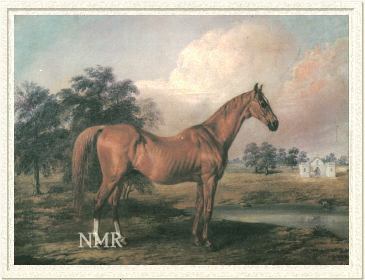 |
|
|
Glencoe was one of the earliest stallions imported into the U.S. to have a long-lasting impact on thoroughbred bloodlines. Although no important male line descendants are extant today, he did found a male dynasty that lasted into the early decades of the Twentieth Century--Hindoo, Hanover, and Hamburg were all outstanding racehorses and sires in the U.S., each in turn producing good sons and daughters that helped shape today's thoroughbred.
His daughters catapulted him to fame in his own time as a broodmare sire. First among them was Pocahontas, bred in England, who produced the amazing trio of sons, Rataplan, King Tom and Stockwell -- "the Emperor of Stallions" -- whose blood courses through so many great thoroughbreds, past and present. In America he sired, among others, Reel, one of that country's most influential broodmares.
His Family
Glencoe was bred by George Child-Villiers, the fifth Earl of Jersey, whose important stud was located at Middleton Stoney in Oxfordshire. The Earl's purchase from the Duke of Grafton of Web (1808, byWaxy), the sister of those two pillars of the studbook, Whisker and Whalebone, laid the foundation of a great branch of Family 1, nurtured at Middleton Stoney. Web had two good racing sons for the Earl -- Middleton, who won the 1825 Epsom Derby, and Glenartney, also a good runner who would have won the Derby two years later, if he had not been pulled. She also had two influential daughters, bred in the Jersey stud, who later produced classic winning offspring at Middleton Stoney.
Web's daughter Filagree (1815) produced 1,000 Guineas and Epsom Oaks winner Cobweb, later the dam of the top race horse and Derby winner Bay Middleton, as well as two other classic winners. Filagree also bred 1,000 Guineas winner Charlotte West and 2,000 Guineas winner Riddlesworth. Other daughters also produced classic winners, and from Filagree descend such horses as Queen Bertha and La Troienne.
Web also produced the chestnut filly Trampoline, in 1825, for the Earl. She was by the top four-miler, Tramp, whose offspring included three classic winners and two winners of the Whip. Trampoline was a fair race filly, who placed second in the 1,000 Guineas, and won a race for three year old fillies at Newmarket. She was retired to the stud in 1829, and produced her first foal, Glenmore, by Phantom, in 1830.
Chart: Glencoe's Close-in Female Family
|
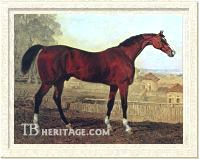
Glencoe's sire, Sultan, could win from 6 furlongs to over 3 miles.
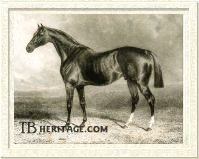
Glencoe as a young stallion; he inherited quite a few features from his sire, but not his color.
| |
Trampoline's second foal, Glencoe, dropped in 1831, was by Sultan, a stallion Lord Jersey used to good effect more than once on Web's daughters and grandaughters to produce classic winners (see the chart). Sultan, a flashy red bay, had a refined head, a longish back, great depth through the girth, and a powerful hind-end, all of which he passed on to his chestnut son, Glencoe. He was a good and game weight carrier, and was sound enough to run to the age of eight. He won the July Stakes at age 2, the Trial Stakes at Newmarket twice, and a number of other races and matches at Newmarket during his long career. Retired to the Marquis of Exeter's stud at Burleigh, he was leading sire in Great Britain for six consecutive years, 1832-37, bolstered by such classic winning sons and daughters as Bay Middleton, Achmet, Green Mantle, Galata, Augustus, Ibrahim, and Destiny, and Glencoe.
Through her daughter, Glencairne (1838), also by Sultan, Trampoline was ancestress of enough good stakes winners to be allotted her own branch of Family 1 (Family 1 - t). The branch has been prolific, and includes such horses as brothers Adalbert (1863, Henckel-Rennen, Union-Rennen) and Gorgo (1865, Union-Rennen), both by Ethelbert; Cherimoya (1908, Epsom Oaks) and her grandson Cameronian (1928, Epsom Derby and 2,000 Guineas); Brie (1875, French Oaks) and her daughter, Brisk (1891, French Oaks); the Australian racehorse and sire Bernborough (1939) by Emborough; The Oak (1901, Italian Derby); the great stayer and leading sire Alycidon (1945); the good American stakes winners Easy Goer (1986) and Sea Hero (1990), and many more. |
Glencoe on the Turf
Glencoe proved to be a youngster of great speed and the "rare Tramp [his dam's sire] staying power." He was born with a long, hollow back, which sank even further in his age; the turf recorder Henry Hall Dixon (The Druid) said his most frequent jockey, the top crack Jem Robinson "...used to look like a man seated in a valley." He was 15.1-3/4 hands at maturity, his coat a rich red chestnut. He had a lovely moulded neck, and inherited the powerful quarters and deep girth of his sire, Sultan.
Glencoe was not started until the age of three. He was put into the hands of the trainer, James "Tiny" Edwards, who schooled many of his famous sire's outstanding offspring, and who later told The Druid that of them all, he "...loved Glencoe best." Edwards was, and still is, the only trainer to win four successive 2,000 Guineas, all four horses bred by the Earl of Jersey and sired by Sultan: Glencoe, in 1834, was the first of these.
Glencoe made his debut in the second Riddlesworth Stakes for three year olds at Newmarket Craven in 1834, which he won in heavy footing over three others in a canter: the purse was £1400. The next day he was sent out in a sweeptstakes of 100 sovereigns against one of the other two top colts of his generation, the big, fast, carthorse-like Plenipotentiary. Robinson was told to wear "Plenipo" down with Glencoe's speed. Robinson later reported, "I came the first half mile as hard as I could lick, but, on looking round, I saw the great fat bullock cantering by my side, Conolly [Plenipo's jockey] at the same time exclaiming, 'I'm here, Master Jemmy, only waiting till I'm wanted.'" Glencoe, spent, was beaten by four lengths.
At the first spring meeting at Newmarket he won the Dessert Stakes in a canter, and followed that by winning the 2,000 Guineas, valued that year at 1750 sovereigns, beating, among others, Viator, the winner of the first Riddlesworth earlier in the spring, and two horses who had been good juveniles, Flatterer, who had won the Grand Duke Michael Stakes, and Bentley, winner of the Clearwell and Criterion Stakes. He then ran third, a half-length out of second, to Plenipotentiary and Shillelah -- whom he later soundly beat -- in the Epsom Derby. At Ascot, Glencoe was withdrawn from the St. James' Palace Stakes to allow Plenipo a walk-over. The next day Glencoe had a walk-over for the Royal Stakes.
Glencoe won the rest of his races that season. In the Goodwood Cup, he met his elders for the first time, including The Saddler (Doncaster Cup winner), Rockingham (Doncaster St. Leger winner), and St. Giles (Derby winner, by Tramp). He and the filly Marpessa, who later was bred to him to produce Pocahontas, received weight from all these horses. St. Giles, Famine, and Marpessa led early, overtaken by the valiant old trooper Colwick and Glencoe; the latter, "light as a feather and full of running," won "in the commonest of canters" by four lengths. Next he won the Racing Stakes, beating three horses, and then at Newmarket Second October won the Garden Stakes, beating the four year old Glaucus and Colwick by four lengths.
In his second season, with Plenipotentiary broken down and permanently retired after the Newmarket spring meeting, Glencoe won the 2-1/2 mile Ascot Gold Cup -- his only race that year -- in a thrilling run with a field of eight. In it, the early pacesetter, Jersey's filly Misnomer, who was Glencoe's "rabbit" for the running, took a four length lead, setting a fast pace. Glencoe was fourth to the Swinley Post, and then made his move, soon passing Misnomer, "skimming over the sod as light and graceful as the dolphin shoots away from the shark." At the betting stand Bran, a fairly decent colt who had won the York St. Leger and placed second in the Doncaster St. Leger, gamely challenged Glencoe, but "Robinson, mute and motionless as a statue, just slightly slackened his hold on Glencoe's head, and sent him in an easy winner."
|
|
Glencoe's Race Record
|
| Year |
Age |
Starts |
1st |
2nd |
3rd |
Unplaced |
| 1834 |
3 |
9 |
7 |
1 |
1 |
0 |
| 1835 |
4 |
1 |
1 |
0 |
0 |
0 |
| Total |
-- |
10 |
8 |
1 |
1 |
0 |
| | In July, Jersey challenged for The Whip with Glencoe, and obtained it with no responses. Glencoe was then retired from racing. The London Sporting Magazine, at the end of his three year old season had exclaimed, "...from his late performances he has shown himself the best horse in the world. Where is there one to be found to meet him at weight for age? Not in England, assuredly."
|
And Glencoe did not, in fact, stay in England long; his destiny as a thoroughbred progenitor lay largely on the other side of the Atlantic Ocean.
Glencoe in the Stud
In America, Irish-born James Jackson (1782), who had emigrated to the U.S. after the turn of the century, built a substantial business in Nashville, and later New Orleans. He had a strong interest in racing and livestock in general, and in 1819 formed a land company with his business associates, purchasing vast amounts of acreage in northern Alabama. He moved his residence to his newly built plantation, Forks of Cypress there in 1821, and later was active in the Alabama State Legislature, both as a representative and then later as president of the State Senate.
In 1814, Jackson had had an interest, and later controlling ownership of the good stallion Pacolet, and subsequently imported several "bred" horses from England, the first notable one being Leviathan, in 1830, purchased for Jackson by Weatherby's, who became the five-time leading sire in America. Leviathan did not stand at Forks of Cypress, but rather at Nashville, in Tennessee, at the farm of Jackson's close racing associate, Colonel George Elliott.
At the end of 1835, Jackson asked Tattersall to try and obtain either Plenipotentiary, the older retired Epsom Derby winner Priam, or Glencoe for him. At the time, Plenipo and Priam were "not to be had for money," although two years later Priam, in fact, was sold to the American partnership Merritt & Co. and sent to the U.S. Glencoe was obtained for Jackson for $10,000 in January of 1836, with the proviso that Jersey have the free breeding of three mares to him. Glencoe spent his first year at stud at Tattersall's Dawley Wall Farm, near Uxbridge, where he covered not only the three Jersey mares, but forty other outside mares. At the end of the 1836 breeding season, Glencoe was shipped to the U.S., arriving in New York to universal admiration, which spread further as he was taken south to Forks of Cypress. |
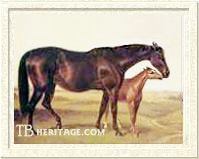
Pocahontas with Stockwell at side.
| |
One of the mares who came to Glencoe's court that spring in England was Marpessa, the game filly he had bested twice on the turf, but who had, despite being a roarer, won and placed in some good races in top company, including the Nursery Stakes at Newmarket. In 1837 she produced the bay filly Pocahontas, who ran between the ages of 2 and 4, and later retired to become one of the most influential broodmares in the history of the thoroughbred (Family 3 - n). Glencoe sired twenty-three foals that lived to maturity in England. In addition to Pocahontas, some of his good offspring there included Ascot Stakes winner Darkness, who in the stud became tail-female ancestress of the French sire Plutus; an unnamed filly out of Frolicksome, who was grandam of the influential sire,Young Melbourne, and an unnamed filly out of Alea, tail-female to Petrarch, a good sire and stakes winner. |
Installed at Forks of Cypress in Alabama, Glencoe was bred in the fall of 1836 to two mares who produced two late foals in 1837. He stood in Alabama for seven years at a fee of $100, and in that time sired 132 foals. Jackson died in 1840; Glencoe stayed in Alabama until 1844, when he was sent by the Jackson estate executors, James and Thomas Kirkman Jr., to Nashville, Tennessee, where he stood for $50 until 1848, when he was sold, now age 17, to W.F. Harper of Midway, Kentucky, for $3,000. His fee was raised to $100 when he was 24 years old, in 1855, the first of two years where he stood beside Lexington at Harper's Nantura Stud. Twenty-one live foals were born from his 1855 covers, and fifteen the following year.
In the summer of 1857, age 26, he was sold to Alexander Keene Richards, who owned Blue Grass Park in Georgetown, Kentucky. Richards owned Glencoe's famous racing daughter, Peytona, who he bred to his imported -- from the Near East -- Arabian stallions. He later purchased and imported Australian, son of the first English Triple Crown winner West Australian, who became an influential sire in the U.S., and owned the important sires Knight of St. George and War Dance, the latter the last foal of the great mare Reel. Richards commissioned Edward Troye to paint Glencoe soon after his purchase, "a truthful portrait...with every wrinkle and spot of age," but in all his grace as a long-lived eminent racehorse. At the time, Richards later reported, Glencoe was in perfect health. Three weeks later, August 25, he died "from a very violent attack of lung fever." The British press reported: "With all his ancient pluck, he stood up bravely against spasmodic colic and lung-fever, for ten days, and died quite exhausted, from bleeding at the nose." He was buried at the Richards farm, later joined by Peytona, who died foaling in 1864.
Turf historian John Hervey calculated Glencoe sired 481 foals in his twenty-two years at stud in Alabama, Tennessee and Kentucky, based on information compiled from the American Stud Book and racing calendars of the day. He pointed out that during the economic depression of 1844 - 48, where the records show only 54 foals by Glencoe, it is likely he got many more youngsters who went unrecorded and others that were never raced or bred. A number who were recorded, from his last crops in Kentucky, were young horses when the Civil War erupted, and their fates are unknown. In 1862, A. Keene Richards presented a son of Glencoe to Confederate raider Col. John Hunt Morgan: "...he was not only a strong, but a big horse. He had the thoroughbred points in a marked degree, but in robust proportions....Big as he was, he was yet extremely nimble and sure-footed." This horse had been used as a model for the mount in a portrait of General Winfield Scott, painted by Edward Troye in the 1850s at Richards' farm.
Glencoe topped the leading sires list eight times in the 1840s and '50s. With his looks and performance record, he got the best mares of his era, both native and imported. The value of the races won by his offspring, compared with leading sires of other decades, is somewhat skewed by the fact that the depression of the 1840s, when most of his youngsters were of racing age, affected both the number of racing opportunities and the size of the purses. He passed on his staying ability to his youngsters, and they dominated three and four mile racing, which was, by the 1840s, declining in popularity. In America, he sired more than twice as many recorded fillies as he did colts, and within his lifetime, it was recognized that his daughters were superior, both on the track and in the breeding shed, to his sons.
|
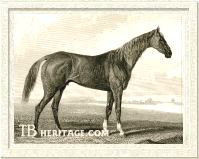
Pryor, Glencoe's best son on the turf
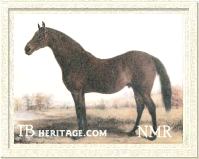
Vandal, Glencoe's best son in the stud. Image used with permission from the National Museum of Racing.
| |
Of his sons, PRYOR ("Prior" in the American Stud Book), foaled in 1852, out of Gipsey, by American Eclipse, was considered the best runner. Bred and owned by Richard Ten Broeck, he ran well in the U.S., his first outing at the Metairie Course in New Orleans, where he won a race for three year olds over a mile, then placed second and third to a Voucher filly, Minnow in two races, finally winning again at Metairie in the fall in two-mile heats. At age 4, he ran against Le Roi, whom he beat handily at the Pharsalia Course at Natchez, Tennessee. Three days later he was matched against the outstanding Reel son (and thus Glencoe's grandson), Lecomte, at Pharsalia, over four miles. In this race, a huge upset, he ran laying back, but within striking distance, and then surged ahead in the last half mile to win the first heat, and the second heat ran in much the same manner, easily besting the tiring Lecomte.
Pryor was shipped to England to race, along with Ten Broeck's great race mare Prioress (1853, by imported Sovereign) and her half-brother, Starke (1855, by Wagner), both of them out of Glencoe's daughter, Reel. Thus, three representatives of Glencoe returned to his native country to race. While Prioress won there, winning the Cesarewitch and other stakes races, and Starke won the Goodwood Cup, the Goodwood Stakes and other races, Pryor was not successful, and he died there without siring anything of note.
|
Another Glencoe son, STAR DAVIS (1849, out of Margaret Wood by Priam) was a fair racehorse and later got Day Star, who beat Himyar in the Kentucky Derby.
Vandal and Virgil
The son who was to have the most impact in the breeding shed was VANDAL (1850), who won races at three mile distances, including the Jockey Club purse at Lexington in 1855, where he defeated another son of Glencoe, Frankfort. Out of a mare by Tranby, and a half-brother to Levity -- later a great producer -- and the gelded Alaric, he was bred by R.A. Alexander, who inherited Woodburn Farm in Kentucky, and turned it into a significant thoroughbred nursery and racing stable. Vandal was a dark bay, and he inherited Glencoe's hollow back. He stood in Kentucky, where he got some good daughters, among them Ella D. (1857), later dam of Bourbon Belle (dam of Hanover), and the good race mare Mollie Jackson (1856), "the best mare of any day." The latter produced Monday, who sired Mollie McCarthy and Joe Hooker in California, and was also dam of Sue Morrissey (Fannie Ludlow) who was second dam of Foxhall. In 1862 he was ranked second to Lexington on the leading sires list. At the age of 19 he was sold by F.T. Kinkead of Kentucky to General William G. Harding, whose Tennessee stud farm, Belle Meade, would later be home to imported Bonnie Scotland. In his final two years with Harding, he got several good racehorses, before his death in 1872, the best probably being his daughter Vandalite (1871), who was the U.S. champion three-year old of 1874.
Vandal also sired the dark bay Virgil, in 1864, out of Hymenia, who was by imported Yorkshire. Virgil was a moderately successful racehorse, who could win up to a mile, and later had some success over fences. Under-appreciated, he was later trained as a buggy horse, and only had an opportunity with some good mares when his owner, Milton H. Sanford, decided to have them covered, rather than lose a season, after his premier stallion at his Preakness Stud in Kentucky, Baywood, fell ill. From just a few mares, Virgil produced some good runners, particularly Vagrant, the best two year old of his generation. After that, Virgil's opportunities at stud dramatically increased, and after he passed to the ownership of Daniel Swigert, who purchased the Preakness Stud, renaming it Elmendorf, he rose to the top of the leading sires list in 1885. Virgil sired Preakness Stakes winner Vanguard, Kentucky Derby winner and fair sire Ben Ali, the champion two year old of 1886, Tremont, and Hindoo, the most noted racehorse of his day, who later continued the revitalization of the Glencoe sire line with his own son, Hanover.
Vandal's son, Voltigeur (1872), sired Princeton, a three-time winner of the challenging Maryland Hunt Cup. Voltigeur also got Nora M., the dam of the foundation Quarter Horse sire Peter McCue (1895). Nora M. was out of the mare Kitty Clyde, by another Glencoe son, Star Davis. Another Vandal son, Versailles (1866), was grandsire of yet another three-time Maryland Hunt Cup winner, Garry Owen.
American Daughters
Glencoe was a remarkable broodmare sire, and many of his fillies were top racehorses as well. First among them was REEL, a grey filly of 1838 from the imported mare Galopade. She was undefeated at a mile, two miles and four miles, until her last race at age 5, when she took a bad step running down the colt, George Martin. In the stud, she produced ten first class racehorses, including Lecomte, who beat Lexington; Prioress, who set course records in the U.S. and then won in England; and Starke, who won several major races in England. Her son, War Dance, became an outstanding sire, and her daughters established a sturdy line of Family 23, leading to such champions as Two Lea, Tim Tam, and Winning Colors. Reel is commonly considered the best American broodmare of the 19th century. |
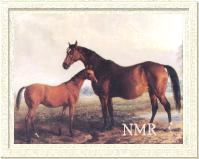
Novice and her foal at Woodburn. Image used with permission from the National Museum of Racing.
| |
NOVICE, out of Chloe Anderson by Rodolph, and bred by R.A. Alexander, at Woodburn Farm in Kentucky, won some races at age 3. As a broodmare in the Woodburn stud, her best son was Norfolk, by Lexington, foaled in 1861. He was purchased for $15,001.00 by Theodore Winters, who made his money in western mining, and went east to purchase the best stallion prospect he could find. Winters ran Norfolk several times in the east to prove his outstanding abilities as a racehorse, and then shipped him by private rail car to his stock farm in northern California, where he ran several races, and then was retired to become a top stallion, despite his limited opportunities. |
Through his son, Emperor of Norfolk, Norfolk was grandsire of Rey del Caredas, who was sent to England to run under the name of Americus, thus ensuring one group of Lexington's descendants -- later encompassing such horses as Nasrullah and Tudor Minstrel -- a place in the General Stud Book, when most others were refused after the Jersey Act of 1913.
PEYTONA was bred by James Jackson at Forks of Cypress, foaled in 1839, shortly before his death, and she was, perhaps the ultimate reflection of his breeding success, her dam being Giantess, by Jackson's first significant import, Leviathan. PEYTONA won $35,000 in the richest event in American racing to that date, the Peyton Stakes, at age 4. She was subsequently matched against Fashion, the great race mare of the North, in a race over the Union Course on Long Island, New York, which she won. When she retired, she had won a total of $62,400, a record that held in the U.S. for fifteen years. Peytona was obtained by Keene Richards for his Blue Grass stud. She was usually bred to Richards' imported arabian stallions in his serious, but ill-fated, attempt to re-introduce "pure" arabian bloodstock into racing. Of her offspring, only her half-arabian daughter, Transylvania, produced anything of note -- the in-bred Limestone, a son of War Dance, who won 19 races in 1874, including stakes races on the flat and over fences.
Next to REEL and PEYTONA, Glencoe's best racing daughter was CHARMER, foaled in 1844 out of the Tennessee race mare Betsey Malone, by Stockholder. One of the Alabama-bred foals, she ran at the age of three unsuccessfully in three races. Sold to W.N. Rogers, at age four she came into her own, defeating, that year, the good horse Revenue in a four mile match. She ran until the age of ten on courses from Cincinnati to New Orleans, winning 27 races of her 40 starts, and she was never beaten in her sixteen starts over three miles. One of her most famous races was a race at Metairie Course, a purse of $700 to be run in four mile heats. She carried the heaviest weight, 115 pounds, against her opponents. She lost the first two heats to the Glencoe gelding Rigadoon, and to Louis d'Or, by Sarpedon. In the third heat, Rigadoon having fallen lame in the second, she dead-heated with Louis d'Or. In the fourth, she bested the exhausted colt, and the fifth heat was a walk-over for her. The four contested heats were the fastest ever recorded to that time. Three days earlier, she had won a $500 purse over three miles, setting a new U.S. record for that distance. That year she also won a $1000 Jockey Club purse for four-mile heats at Charleston, and another for $600 over two miles a few days later. She retired to the farm of William Brunton in Iowa, for whom she produced five foals. She was second dam, through daughter Maggie Mitchell, of sisters Marian and Roxaline, both bred in Illinois, and both by Malcolm. Marian was purchased by Theodore Winters, and became the foundation mare of his California farm, producing Emperor of Norfolk, El Rio Rey, the great race mare Yo Tambien, and five other stakes winners. Roxaline was sent to Canada, where she produced winners of 120 races. Charmer's full sister, Jenny Lind, was also a good race mare.
FLORINE (1854, out of Melody by Medoc), produced the brown race mare Idlewild (1859), by Lexington, and her sister Aerolite (1862). Idlewild won six of her eight races at age 3, including a Purse for All Ages stakes in three straight mile heats at Woodlawn Course. At age 4, with the outbreak of the Civil War, Idlewild's opportunities were limited, but she won all three of her races in Kentucky, and at age 5, she won two races, and then lost to a colt by imported Sovereign. Shipped north, she won four races, her last a four mile dash for all ages at Centreville Course, beating Jerome Edgar and Dangerous. Retired to Woodburn stud in Kentucky, she was bred only to imported Australian; her son, Wildidle (1870), by imported Australian, was a stakes winner in Kentucky and California, who later got the Pacific Derby winner Flambeau for Leland Stanford.
Florine's daughter Aerolite became the dam of top racehorses and brothers Fellowcraft, whose daughter was dam of champion and leading sire Hamburg; Miser; and champion Spendthrift, and through the latter ancestress of Fair Play.
The Glencoe daughter MAGNOLIA (1841, out of Myrtle by Mameluke) was dam of the good racing brothers Daniel Boone (1856) and Kentucky (1861), both by Lexington, and of the good race mare Skedaddle by imported Yorkshire, later dam of Saucebox, Slyboots, and other winners. His daughter TOPAZ (1844, out of Emerald by Leviathan) produced the good race horses and later sires, Waterloo, Austerlitz and Wagram, and Lodi, who ran on the west coast. Fanny King (1841, out of Mary Smith by Sir Richard) produced Brown Dick (1850, by Margrave), a good racehorse in his time, whose record for three-mile heats run in 1856 stood for nine years.
Glencoe sired at least 317 fillies, and many bred on, now interwoven into the pedigrees of thoroughbreds today. Many have noted that Lexington was helped to dominance of the sire lists for so many years by Glencoe, on whose daughters he was so frequently and successfully crossed. In like respect, Glencoe's status as leading sire for eight years was well-supported by the daughters of his first owner's -- James Jackson -- earlier imported stallion, Leviathan.
--Patricia Erigero |
|
|
|

